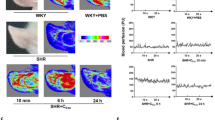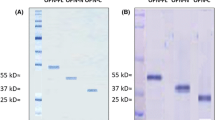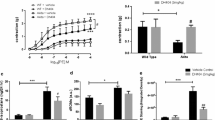Abstract
There is growing evidence suggesting that circulating fibrocytes (CFs) play a pivotal role in tissue repair and fibrosis. In contrast, in recent studies, angiotensin-(1-7) [Ang-(1-7)] has been shown to antagonize fibrosis. The purpose of this study was to examine the direct effect of Ang-(1-7) on CFs. Total mononuclear cells (MNCs) were isolated from peripheral blood by Ficoll density gradient centrifugation. Using laser scanning confocal microscopy, CFs were identified as adherent cells that stained positive for both CD34 and collagen-I. After 14 days of culture, CFs were stimulated with Ang-(1-7) at concentrations of 10 nM, 100 nM, 1 μM or 10 μM, in the absence and presence of pretreatment with A-779, NG-nitro-l-arginine methyl ester (L-NAME) or both, for 24, 48 or 72 h. The number of cells, cellular proliferation, and level of apoptosis were determined by hematoxylin and eosin staining, the Cell Counting Kit-8 (CCK8) assay and the annexin V/propidium iodide binding assay, respectively. The collagen content of CFs was measured by the concentration of hydroxyproline, which was detected using the enzymatic digestion method. The expression of endothelial nitric oxide synthase (eNOS) was assayed by western Blot analysis, while nitric oxide (NO) generation was detected using the Griess method. We found that Ang-(1-7) increases apoptosis and eNOS/NO production in CFs. In addition, Ang-(1-7) decreases the number, proliferative capacity and collagen-secretion of CFs in a concentration- and time-dependent manner. These data suggest that Ang-(1-7) suppresses the both the number and function of CFs possibly by increasing eNOS/NO production in the CFs.





Similar content being viewed by others
References
Bucala R, Spiegel LA, Chesney J, Hogan M, Cerami A (1994) Circulating fibrocytes define a new leukocyte subpopulation that mediates tissue repair. Mol Med 1:71–81
Wada T, Sakai N, Sakai Y, Matsushima K, Kaneko S, Furuichi K (2011) Involvement of bone-marrow-derived cells in kidney fibrosis. Clin Exp Nephrol 15:8–13. doi:10.1007/s10157-010-0372-2
Varcoe RL, Mikhail M, Guiffre AK, Pennings G, Vicaretti M, Hawthorne WJ, Fletcher JP, Medbury HJ (2006) The role of the fibrocyte in intimal hyperplasia. J Thromb Haemost 4:1125–1133. doi:10.1111/j.1538-7836.2006.01924.x
Bellini A, Mattoli S (2007) The role of the fibrocyte, a bone marrow-derived mesenchymal progenitor, in reactive and reparative fibroses. Lab Invest 87:858–870. doi:10.1038/labinvest.3700654
Quan TE, Cowper SE, Bucala R (2006) The role of circulating fibrocytes in fibrosis. Curr Rheumatol Rep 8:145–150
Krenning G, Zeisberg EM, Kalluri R (2010) The origin of fibroblasts and mechanism of cardiac fibrosis. J Cell Physiol 225:631–637. doi:10.1002/jcp.22322
Breitschaft A, Stahlmann R (2009) Nephrogenic systemic fibrosis. Med Monatsschr Pharm 32:377–382
Suvorava T, Kumpf S, Rauch BH, Dao VT, Adams V, Kojda G (2010) Hydrogen peroxide inhibits exercise-induced increase of circulating stem cells with endothelial progenitor capacity. Free Radic Res 44:199–207. doi:10.3109/10715760903402898
Schmidt D, Achermann J, Odermatt B, Breymann C, Mol A, Genoni M, Zund G, Hoerstrup SP (2007) Prenatally fabricated autologous human living heart valves based on amniotic fluid derived progenitor cells as single cell source. Circulation 116:I64–I70. doi:10.1161/CIRCULATIONAHA.106.681494
Chen TG, Chen JZ, Wang XX (2006) Effects of rapamycin on number activity and eNOS of endothelial progenitor cells from peripheral blood. Cell Prolif 39:117–125. doi:10.1111/j.1365-2184.2006.00375.x
Velkoska E, Dean RG, Griggs K, Burchill L, Burrell LM (2011) Angiotensin-(1–7) infusion is associated with increased blood pressure and adverse cardiac remodelling in rats with subtotal nephrectomy. Clin Sci (Lond) 120:335–345. doi:10.1042/CS20100280
Sampaio WO, Souza dos Santos RA, Faria-Silva R, da Mata Machado LT, Schiffrin EL, Touyz RM (2007) Angiotensin-(1–7) through receptor Mas mediates endothelial nitric oxide synthase activation via Akt-dependent pathways. Hypertension 49:185–192. doi:10.1161/01.HYP.0000251865.35728.2f
Vannella KM, McMillan TR, Charbeneau RP, Wilke CA, Thomas PE, Toews GB, Peters-Golden M, Moore BB (2007) Cysteinyl leukotrienes are autocrine and paracrine regulators of fibrocyte function. J Immunol 179:7883–7890
Salmon M, Pilling D, Borthwick NJ, Viner N, Janossy G, Bacon PA, Akbar AN (1994) The progressive differentiation of primed T cells is associated with an increasing susceptibility to apoptosis. Eur J Immunol 24:892–899. doi:10.1002/eji.1830240417
Pilling D, Akbar AN, Bacon PA, Salmon M (1996) CD4 + CD45RA + T cells from adults respond to recall antigens after CD28 ligation. Int Immunol 8:1737–1742
Iwata M, Cowling RT, Gurantz D, Moore C, Zhang S, Yuan JX, Greenberg BH (2005) Angiotensin-(1–7) binds to specific receptors on cardiac fibroblasts to initiate antifibrotic and antitrophic effects. Am J Physiol Heart Circ Physiol 289:H2356–H2363. doi:10.1152/ajpheart.00317.2005
Lama VN, Phan SH (2006) The extrapulmonary origin of fibroblasts: stem/progenitor cells and beyond. Proc Am Thorac Soc 3:373–376. doi:10.1513/pats.200512-133TK
Mori L, Bellini A, Stacey MA, Schmidt M, Mattoli S (2005) Fibrocytes contribute to the myofibroblast population in wounded skin and originate from the bone marrow. Exp Cell Res 304:81–90. doi:10.1016/j.yexcr.2004.11.011
Kim YH, Song JJ, Kim YC, Park KT, Lee JH, Choi JM, Oh SH, Chang SO (2010) Geranylgeranylacetone ameliorates acute cochlear damage caused by 3-nitropropionic acid. Neurotoxicology 31:317–325. doi:10.1016/j.neuro.2010.03.001
Luo W, Zhou X, Zhang J, Qian Y, Zheng M, Yu M, Gong X (2007) Analysis of apoptosis and cell proliferation after high intensity-focused ultrasound ablation combined with microbubbles in rabbit livers. Eur J Gastroenterol Hepatol 19:962–968. doi:10.1097/MEG.0b013e3282cfb6f
Yang L, Yang XC, Yang JK, Guo YH, Yi FF, Fan Q, Liu XL (2008) Cyclosporin A suppresses proliferation of endothelial progenitor cells: involvement of nitric oxide synthase inhibition. Intern Med 47:1457–1464
Villegas J, Schulz M, Soto L, Sanchez R (2005) Bacteria induce expression of apoptosis in human spermatozoa. Apoptosis 10:105–110. doi:10.1007/s10495-005-6065-8
Spallarossa P, Garibaldi S, Altieri P, Fabbi P, Manca V, Nasti S, Rossettin P, Ghigliotti G, Ballestrero A, Patrone F, Barsotti A, Brunelli C (2004) Carvedilol prevents doxorubicin-induced free radical release and apoptosis in cardiomyocytes in vitro. J Mol Cell Cardiol 37:837–846. doi:10.1016/j.yjmcc.2004.05.024
Liu X, Fan XL, Zhao Y, Luo GR, Li XP, Li R, Le WD (2005) Estrogen provides neuroprotection against activated microglia-induced dopaminergic neuronal injury through both estrogen receptor-alpha and estrogen receptor-beta in microglia. J Neurosci Res 81:653–665. doi:10.1002/jnr.20583
Quan TE, Cowper S, Wu SP, Bockenstedt LK, Bucala R (2004) Circulating fibrocytes: collagen-secreting cells of the peripheral blood. Int J Biochem Cell Biol 36:598–606. doi:10.1016/j.biocel.2003.10.005
Chesney J, Metz C, Stavitsky AB, Bacher M, Bucala R (1998) Regulated production of type I collagen and inflammatory cytokines by peripheral blood fibrocytes. J Immunol 160:419–425
Wynn TA (2008) Cellular and molecular mechanisms of fibrosis. J Pathol 214:199–210. doi:10.1002/path.2277
Abu El-Asrar AM, Struyf S, Van Damme J, Geboes K (2008) Circulating fibrocytes contribute to the myofibroblast population in proliferative vitreoretinopathy epiretinal membranes. Br J Ophthalmol 92:699–704. doi:10.1136/bjo.2007.134346
Abe R, Donnelly SC, Peng T, Bucala R, Metz CN (2001) Peripheral blood fibrocytes: differentiation pathway and migration to wound sites. J Immunol 166:7556–7562
Hartlapp I, Abe R, Saeed RW, Peng T, Voelter W, Bucala R, Metz CN (2001) Fibrocytes induce an angiogenic phenotype in cultured endothelial cells and promote angiogenesis in vivo. FASEB J 15:2215–2224. doi:10.1096/fj.01-0049com
Averill DB, Ishiyama Y, Chappell MC, Ferrario CM (2003) Cardiac angiotensin-(1–7) in ischemic cardiomyopathy. Circulation 108:2141–2146. doi:10.1161/01.CIR.0000092888.63239.54
Ferreira AJ, Santos RA, Almeida AP (2002) Angiotensin-(1–7) improves the post-ischemic function in isolated perfused rat hearts. Braz J Med Biol Res 35:1083–1090
Ferreira AJ, Santos RA, Almeida AP (2001) Angiotensin-(1–7): cardioprotective effect in myocardial ischemia/reperfusion. Hypertension 38:665–668
De Mello WC (2004) Angiotensin (1–7) re-establishes impulse conduction in cardiac muscle during ischaemia-reperfusion. The role of the sodium pump. J Renin Angiotensin Aldosterone Syst 5:203–208. doi:10.3317/jraas.2004.041
Loot AE, Roks AJ, Henning RH, Tio RA, Suurmeijer AJ, Boomsma F, van Gilst WH (2002) Angiotensin-(1–7) attenuates the development of heart failure after myocardial infarction in rats. Circulation 105:1548–1550
Grobe JL, Mecca AP, Lingis M, Shenoy V, Bolton TA, Machado JM, Speth RC, Raizada MK, Katovich MJ (2007) Prevention of angiotensin II-induced cardiac remodeling by angiotensin-(1–7). Am J Physiol Heart Circ Physiol 292:H736–H742. doi:10.1152/ajpheart.00937.2006
Grobe JL, Mecca AP, Mao H, Katovich MJ (2006) Chronic angiotensin-(1–7) prevents cardiac fibrosis in DOCA-salt model of hypertension. Am J Physiol Heart Circ Physiol 290:H2417–H2423. doi:10.1152/ajpheart.01170.2005
Zisman LS, Keller RS, Weaver B, Lin Q, Speth R, Bristow MR, Canver CC (2003) Increased angiotensin-(1–7)-forming activity in failing human heart ventricles: evidence for upregulation of the angiotensin-converting enzyme Homologue ACE2. Circulation 108:1707–1712. doi:10.1161/01.CIR.0000094734.67990.99
Grobe JL, Der Sarkissian S, Stewart JM, Meszaros JG, Raizada MK, Katovich MJ (2007) ACE2 overexpression inhibits hypoxia-induced collagen production by cardiac fibroblasts. Clin Sci (Lond) 113:357–364. doi:10.1042/CS20070160
Bindom SM, Hans CP, Xia H, Boulares AH, Lazartigues E (2010) Angiotensin I-converting enzyme type 2 (ACE2) gene therapy improves glycemic control in diabetic mice. Diabetes 59:2540–2548. doi:10.2337/db09-0782
Dejean L, Camara Y, Sibille B, Solanes G, Villarroya F (2004) Uncoupling protein-3 sensitizes cells to mitochondrial-dependent stimulus of apoptosis. J Cell Physiol 201:294–304. doi:10.1002/jcp.20048
Feng J, Bianchi C, Sandmeyer JL, Sellke FW (2005) Bradykinin preconditioning improves the profile of cell survival proteins and limits apoptosis after cardioplegic arrest. Circulation 112:I190–I195. doi:10.1161/CIRCULATIONAHA.104.524454
Seidman R, Gitelman I, Sagi O, Horwitz SB, Wolfson M (2001) The role of ERK 1/2 and p38 MAP-kinase pathways in taxol-induced apoptosis in human ovarian carcinoma cells. Exp Cell Res 268:84–92. doi:10.1006/excr.2001.5262
Kasahara E, Sato EF, Miyoshi M, Konaka R, Hiramoto K, Sasaki J, Tokuda M, Nakano Y, Inoue M (2002) Role of oxidative stress in germ cell apoptosis induced by di(2-ethylhexyl)phthalate. Biochem J 365:849–856. doi:10.1042/BJ20020254
Shacter E, Williams JA, Hinson RM, Senturker S, Lee YJ (2000) Oxidative stress interferes with cancer chemotherapy: inhibition of lymphoma cell apoptosis and phagocytosis. Blood 96:307–313
Gonzales S, Noriega GO, Tomaro ML, Pena C (2002) Angiotensin-(1–7) stimulates oxidative stress in rat kidney. Regul Pept 106:67–70
Acknowledgments
This study is supported by the grants from the National Natural Science Foundation of China (No.81070082 and No.30900614).
Author information
Authors and Affiliations
Corresponding author
Rights and permissions
About this article
Cite this article
Wang, K., Hu, X., Du, C. et al. Angiotensin-(1-7) suppresses the number and function of the circulating fibrocytes by upregulating endothelial nitric oxide synthase expression. Mol Cell Biochem 365, 19–27 (2012). https://doi.org/10.1007/s11010-012-1223-0
Received:
Accepted:
Published:
Issue Date:
DOI: https://doi.org/10.1007/s11010-012-1223-0




